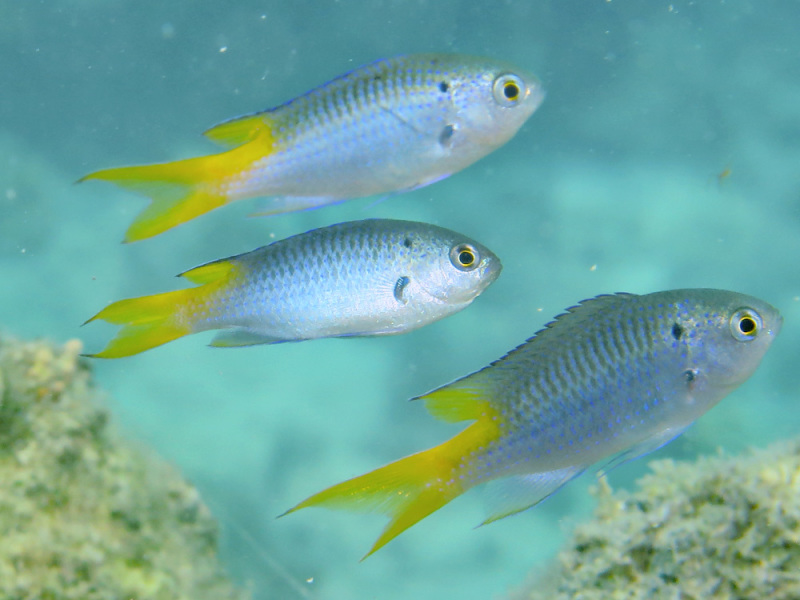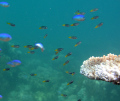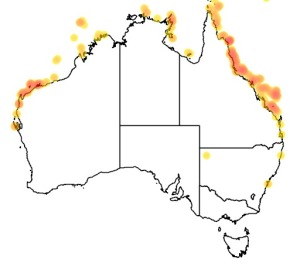
©Anne Hoggett: Neopomacentrus azysron at Big Vicki's Reef, Lizard Island. Note yellow on rear of dorsal fin is connected to yellow of tail, and dark spot above pectoral fin.

©Anne Hoggett: A large (7-8 cm), solitary Neopomacentrus azysron in a reef front canyon at South Island, Lizard Island Group.
Colours
Distinguishing features
A small blue-grey fish with orange-yellow on the rear dorsal fin and a yellow tail, and a small dark "ear-spot" behind the eye. Usually seen schooling above corals in shallow water, often in mixed schools with Neopomacentrus cyanomos. N. azysron is distinguishable by the contiguous yellow which connects the rear of the dorsal fin with the tail. When the two species forage in mixed schools, the N. azysron usually aggregate together at the leading edge of the school, highest in the water column and furthest from shelter.
Size
- Up to 8 cm (Standard length)
Depth range
- Depth range data is not yet available.
Synonyms
Similar taxa
-
Animalia:
Chinese Demoiselle (species: Neopomacentrus bankieri)
lacks a dark spot above the pectoral fin (but does have one at the base of the pectoral fin), has the same distribution of yellow (tail and rear dorsal fin, yellow is contiguous), and body colour is less blue and more grey. There are numerous records of the species in the Lizard Island area in Atlas of Living Australia (accessed 19 Nov 2022) but they may be misidentifications for Neopomacentrus azysron.
Distribution
Distribution and habitat preferences
Found in nearly all habitats around the island, although most common in shallow lagoonal and backreef areas with abundant hard coral and good current flow.
Found in most locations around the Island.
Behaviour
The Yellowtail Demoiselle is a common plankton feeding damselfish found all around Lizard Island and throughout the GBR. It aggregates in large schools over the top of suitable hard coral shelter, and is commonly targeted by predators such as Trevallies and Rock Cods. Despite its abundance, there is little published information on the ecology of this species. Like other damselfish, the males establish a benthic nest and court females to encourage egg deposition, and the eggs hatch after a short incubation of 3-5d. The juveniles settle to the reef in large groups, and take up position next to the adult feeding schools. At Walker Reef, we found this species recruited in large groups to the backreef habitats during summer, and then progressively moved into the other lagoonal habitats during the early autumn. Populations of the Yellowtail Demoiselle appear to have rapid turnover which suggests this species is relatively short-lived.
Web resources
References
- Arias-González, J.E., T.J. Done, C.A. Page, A.J. Cheal, S. Kininmonth and J.R. Garza-Pérez (2006). Towards a reefscape ecology: relating biomass and trophic structure of fish assemblages to habitat at Davies Reef, Australia, Marine Ecology Progress Series, 320: 29-41. LIRS catalog number 90099.
- Bellwood, D.R., A.S. Hoey, J.L. Ackerman and M. Depczynski (2006). Coral bleaching, reef fish community phase shifts and the resilience of coral reefs, Global Change Biology, 12: 1587-1594. LIRS catalog number 90100.
- Booth, D.J. (2002). Distribution changes after settlement in six species of damselfish (Pomacentridae) in One Tree Island lagoon, Great Barrier Reef, Marine Ecology Progress Series, 226: 157-164. LIRS catalog number 90094.
- View all references



